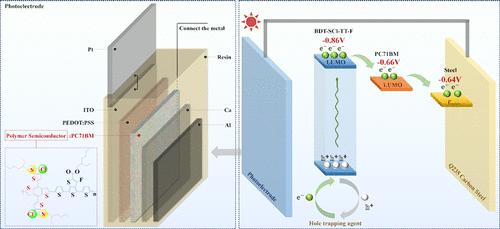释放有机半导体的潜力:协同烷基硫代卤素取代优越的光电化学阴极保护
IF 5.2
1区 化学
Q1 POLYMER SCIENCE
引用次数: 0
摘要
本研究设计并合成了7种基于苯并二噻吩和氟化噻吩共轭骨架的有机聚合物半导体。这些包括未改性的聚合物,用烷氧基、烷基硫基、氟或氯单独取代的聚合物,以及烷基硫基和F(或Cl)协同取代的聚合物。这种协同取代不仅在分子水平上优化了几何和电子结构,而且在宏观器件上实现了高性能的光电阴极保护。协同取代聚合物的HOMO/LUMO能级分别为- 5.51/ -3.54 eV(带隙1.97 eV)和- 5.47/ -3.52 eV(带隙1.95 eV)。分子间F··S和Cl··S相互作用使π -π堆积距离减小到4.48 Å,形成了明确的微相分离和块体异质结互穿网络。这些聚合物的载流子寿命分别延长了4.47和4.10 ns,激子复合时间分别延长了214.8和209.9 μs,电荷输运时间分别缩短了41.7和31.9 μs,优于单取代和未修饰的聚合物。此外,它们的双层电容显著增强,表明电化学活性位点密度更高。在保护Q235碳钢的过程中,在空穴清除剂存在的情况下,协同取代的聚合物将开路电位降低到0.822和0.831 V,保持了70.7和62.5 μA cm-2的高光电流密度,显著降低了界面电荷转移电阻,并使总阻抗最小。极化测试进一步证明了最高的稳态电流和最低的极化电阻,反映了优异的极化行为和工作稳定性。即使在3.5 wt %的NaCl环境中,这些聚合物由于其低HOMO水平而保持阴极保护能力,这有助于析氧反应提供电子。该策略显著提高了载流子分离/输运效率和耐腐蚀性,为高性能有机光电阴极保护材料的开发提供了新的途径。本文章由计算机程序翻译,如有差异,请以英文原文为准。

Unlocking the Potential of Organic Semiconductors: Synergistic Alkylthio-Halogen Substitutions for Superior Photoelectrochemical Cathodic Protection
In this study, seven organic polymer semiconductors based on benzodithiophene and fluorinated thiophene conjugated backbones were designed and synthesized. These included the unmodified polymer, polymers singly substituted with alkoxy, alkylthio, fluorine, or chlorine, as well as polymers with synergistic substitutions of alkylthio and F (or Cl). The synergistic substitution not only optimized the geometric and electronic structures at the molecular level but also enabled high-performance photoelectrochemical cathodic protection in macroscopic devices. The synergistically substituted polymers exhibited HOMO/LUMO energy levels of −5.51/–3.54 eV (bandgap 1.97 eV) and −5.47/–3.52 eV (bandgap 1.95 eV). Intermolecular F···S and Cl···S interactions reduced the π–π stacking distance to 4.48 Å, resulting in well-defined microphase separation and an interpenetrating network in the bulk heterojunction. These polymers showed extended carrier lifetimes of up to 4.47 and 4.10 ns, prolonged exciton recombination times of 214.8 and 209.9 μs, and shortened charge transport times of only 41.7 and 31.9 μs─superior to their singly substituted and unmodified counterparts. Moreover, their double-layer capacitance was significantly enhanced, indicating a higher density of electrochemically active sites. In protecting Q235 carbon steel, the synergistically substituted polymers reduced the open-circuit potential to 0.822 and 0.831 V in the presence of a hole scavenger, maintained high photocurrent densities of 70.7 and 62.5 μA cm–2, significantly decreased interfacial charge transfer resistance, and minimized overall impedance. Polarization tests further demonstrated the highest steady-state currents and the lowest polarization resistances, reflecting excellent polarization behavior and operational stability. Even in a 3.5 wt % NaCl environment, these polymers maintained cathodic protection capabilities due to their low HOMO levels, which facilitated oxygen evolution reactions to supply electrons. This strategy markedly improved carrier separation/transport efficiency and corrosion resistance, offering a new avenue for the development of high-performance organic photoelectrochemical cathodic protection materials.
求助全文
通过发布文献求助,成功后即可免费获取论文全文。
去求助
来源期刊

Macromolecules
工程技术-高分子科学
CiteScore
9.30
自引率
16.40%
发文量
942
审稿时长
2 months
期刊介绍:
Macromolecules publishes original, fundamental, and impactful research on all aspects of polymer science. Topics of interest include synthesis (e.g., controlled polymerizations, polymerization catalysis, post polymerization modification, new monomer structures and polymer architectures, and polymerization mechanisms/kinetics analysis); phase behavior, thermodynamics, dynamic, and ordering/disordering phenomena (e.g., self-assembly, gelation, crystallization, solution/melt/solid-state characteristics); structure and properties (e.g., mechanical and rheological properties, surface/interfacial characteristics, electronic and transport properties); new state of the art characterization (e.g., spectroscopy, scattering, microscopy, rheology), simulation (e.g., Monte Carlo, molecular dynamics, multi-scale/coarse-grained modeling), and theoretical methods. Renewable/sustainable polymers, polymer networks, responsive polymers, electro-, magneto- and opto-active macromolecules, inorganic polymers, charge-transporting polymers (ion-containing, semiconducting, and conducting), nanostructured polymers, and polymer composites are also of interest. Typical papers published in Macromolecules showcase important and innovative concepts, experimental methods/observations, and theoretical/computational approaches that demonstrate a fundamental advance in the understanding of polymers.
 求助内容:
求助内容: 应助结果提醒方式:
应助结果提醒方式:


